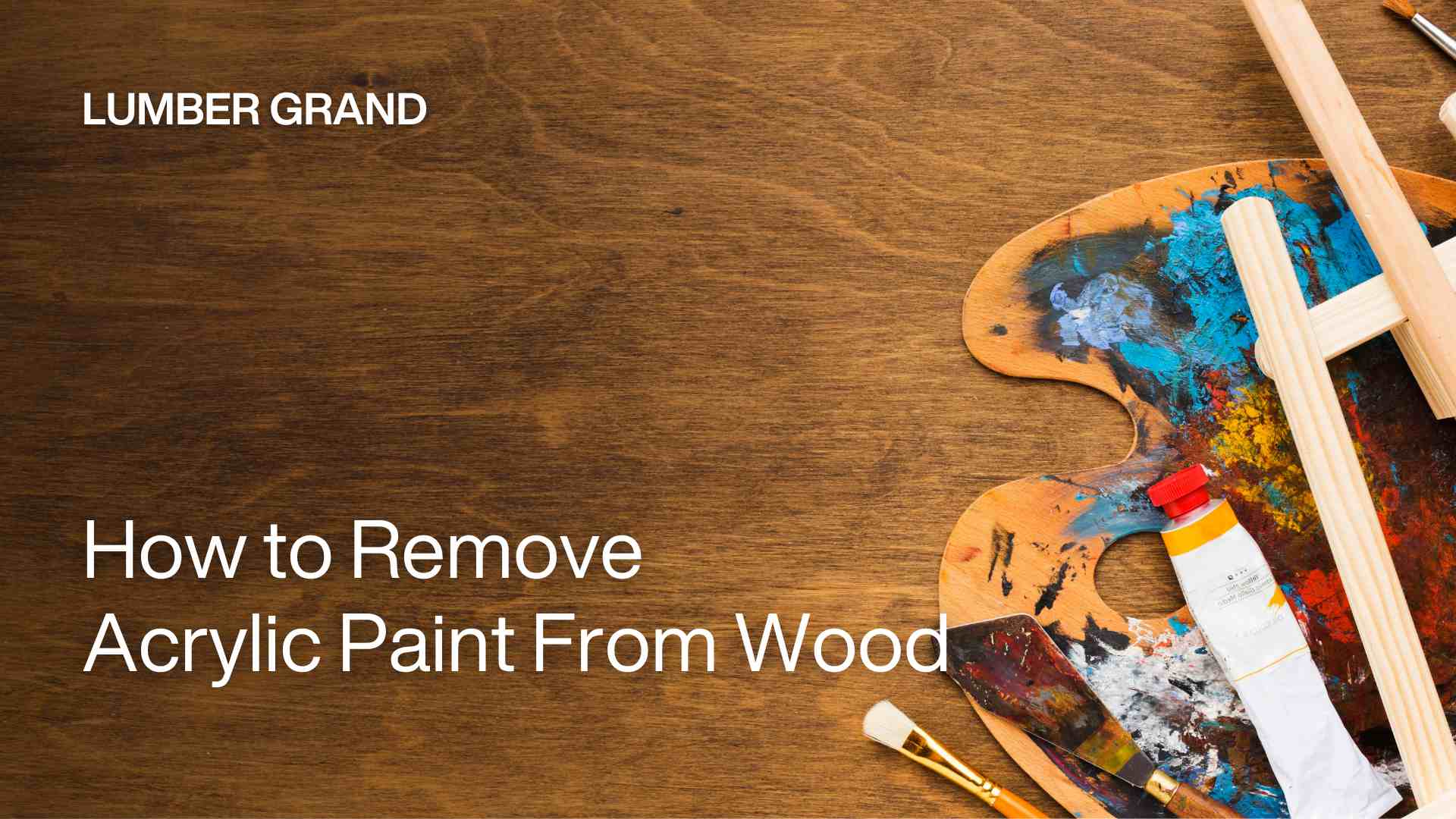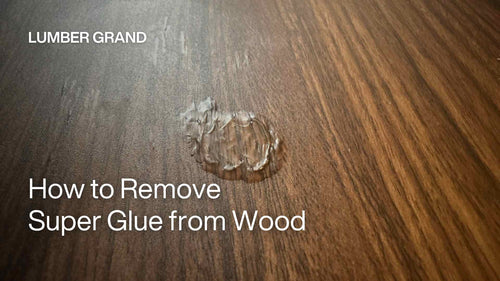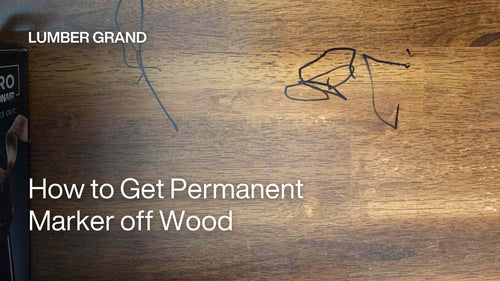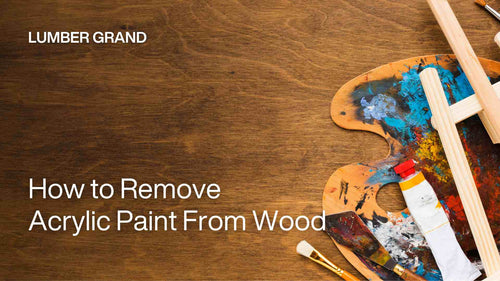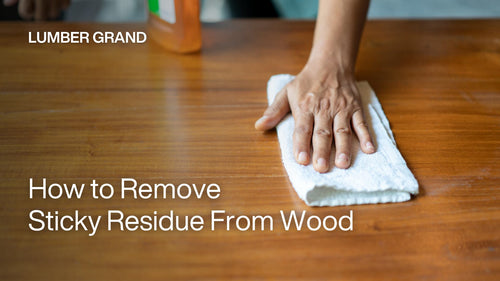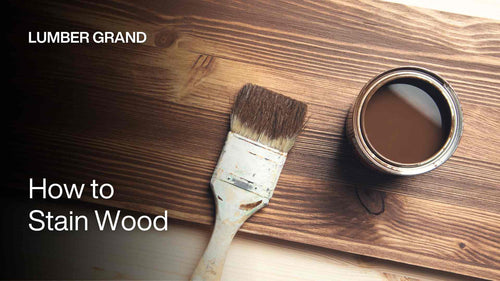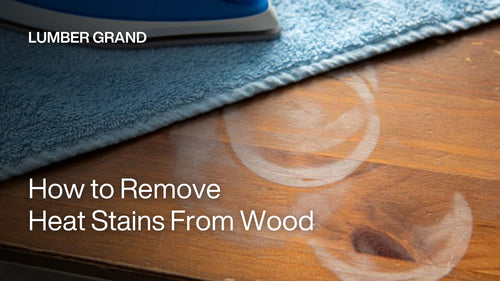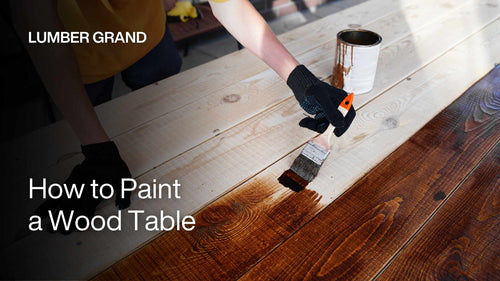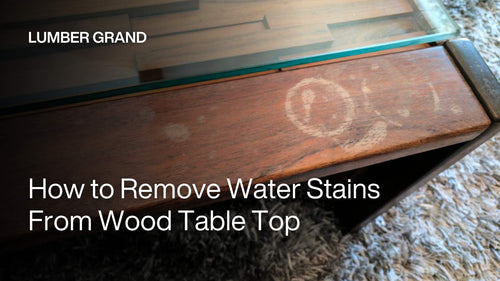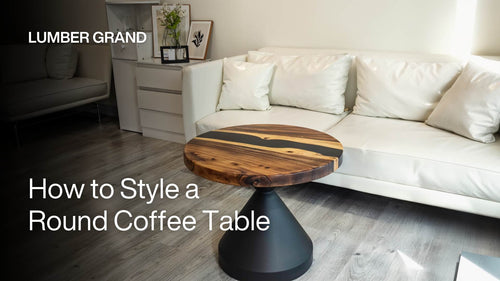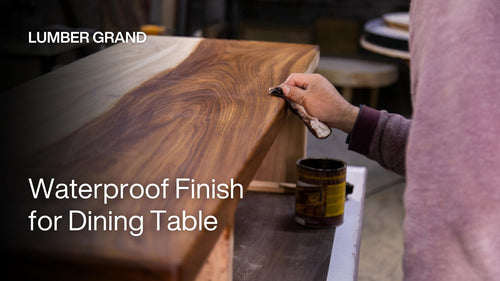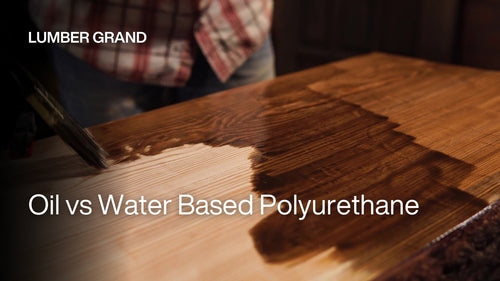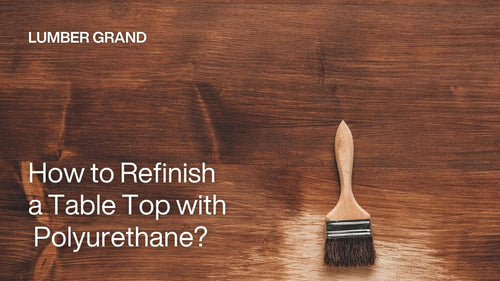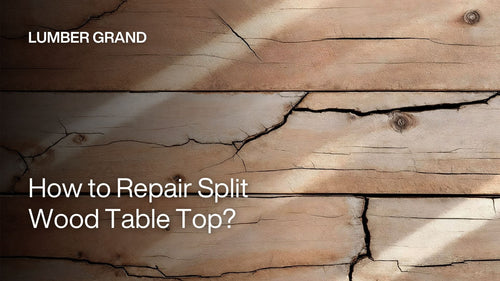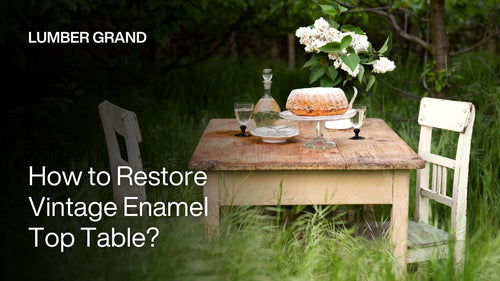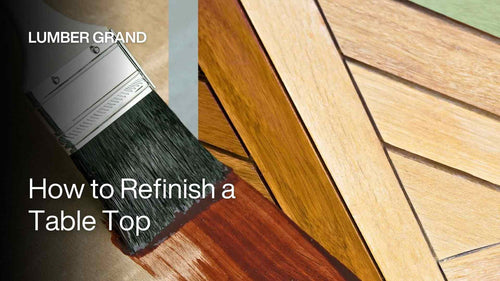Got acrylic paint on your wood? Maybe you just wrapped up a DIY project or caught some splatter while painting a room. Either way, you need to know how to remove acrylic paint from wood to make it disappear quickly.
The cool thing is that removing acrylic paint from wood doesn't need special tools or sandpaper. Grab a few household items and about 10 minutes of your time. Lumber Grand is covering 7 fast and safe methods for how you remove acrylic paint from wood. Read more!
Is Acrylic Paint Permanent on Wood?
No, acrylic paint sticks to wood pretty well, but it's not set in stone, especially if you catch it early. That means the faster you deal with it, the easier it comes off.
-
Fresh spills: If the paint's still wet, soap and water will take it right off. It hasn't bonded to the wood yet.
-
Dried paint: Acrylic dries fast, usually within 20 to 30 minutes. Once it's dry, it becomes water-resistant and tougher to remove. But you can still get it off with the right products and a bit of effort (which we'll reveal in our guide below)
-
Sealed finishes: Now, if someone prepped the wood with primer, put on multiple coats, and sealed everything with a topcoat, that's a different story. Those finishes can last 5 to 10 years or more, and they're way harder to strip.

How do you remove acrylic paint from wood
Photo: Freepik
You can learn more in Lumber Grand’s detailed guide on how to remove paint from wood.
Best Ways to Remove Acrylic Paint from Wood: Quick Wood Rescue Chart
Lumber Grand has summarized 7 quick and effective methods to help you choose the right acrylic paint remover for wood. Don’t forget to scroll down for the full step-by-step guide.
|
Method |
Works Best For |
Time |
Safety Level |
|
Soap + Water |
Fresh or slightly wet paint |
5 — 10 minutes |
Very safe |
|
Magic Eraser |
Light stains on finished wood |
5 — 15 minutes |
Safe but slightly abrasive (test on a small area first) |
|
Olive Oil |
Dried paint on sealed or varnished wood |
30 — 60 minutes |
Safe |
|
Goo Gone (or Similar Remover) |
Stubborn, sticky, or old paint spots |
10 — 20 minutes |
Moderate (may dull finish if left too long) |
|
Rubbing Alcohol |
Dried acrylic paint on most wood surfaces |
10 — 20 minutes |
Use with care |
|
Denatured Alcohol |
Thick or aged layers on unfinished wood |
10 — 20 minutes |
Strong solvent (avoid glossy or dark finishes) |
|
Acetone |
Very stubborn, sealed multi-layer paint |
10 — 20 minutes |
Use cautiously (may strip finish or color) |
Latest blog this week: How to Stain Wood
How to Remove Acrylic Paint from Wood: 7 Fast and Effective Methods
You’ve probably found the ideal method for your situation from the table above. Now, let’s walk through the step-by-step instructions for each of the 7 methods. So, you can easily follow along and try them at home.
1. Soap + Water — First Line of Defense for Fresh Acrylic Paint
Best for: Fresh paint (still tacky), small spills, water-based acrylic paint only
A simple soap and water is the best way to remove acrylic paint from wood table tops. It works like a charm on fresh or slightly dried paint, and it won't damage your wood finish.
What you’ll need:
-
1 teaspoon of dish soap or Murphy's Oil Soap
-
1 cup of warm water
-
Microfiber cloth
-
Dry towel
Follow these steps:
-
Step 1: First, you combine dish soap or Murphy's Oil Soap with warm water
-
Step 2: Soak a towel in a dish soap or Murphy's Oil Soap and warm water mixture
-
Step 3: Wring the towel gently so it is damp, not soaking wet.
-
Step 4: Lightly scrub the paint stain. If the towel gets too paint-covered, use a different towel to avoid smearing the paint.
-
Step 5: Continue to scrub the stain until the area is clean
-
Step 6: When the area is all clean, use a clean towel to dry the entire surface
Note: Will Dawn dish soap remove acrylic paint? Yes, a solution of Dawn dish soap and hot water can also be utilized to eliminate wet acrylic paint. The method is similar to the detailed instructions above.

How to remove acrylic paint from stained wood with soap and water
Photo: Tanya HomeInspo
2. Magic Eraser — Perfect for Light Surface Marks
Best for: Thin, dried layers of paint on sealed wood or light-colored surfaces
A Magic Eraser is a cleaning tool made from melamine foam. When combined with water, it acts as a micro-abrasive to remove stubborn stains and dirt from many surfaces. And Magic Eraser works like magic when it comes to how to remove acrylic paint from varnished wood.
What you’ll need:
-
A Magic Eraser (or generic melamine foam)
-
Water
-
A clean towel
Do this simple how-to:
-
Step 1: First, we dampen the Magic Eraser with water. Squeeze out excess water (but do not wring it out)
-
Step 2: Gently rub the magic eraser on the paint stain in small circles or toward the wood grain. You’ll see the paint stain completely removed.
-
Step 3: Continue rubbing any other acrylic paint stains, if any. Do not use too much force, as this may wear away the wood finish
-
Step 4: Use a clean cloth to wipe off excess water and dry the table completely
Note: You should first test on a small area to ensure the Magic Eraser does not damage the wood finish.

How to remove acrylic paint from wood without sanding
Photo: Apartment Therapy
You might like: How to Remove Heat Stains from Wood
3. Olive Oil — Gentle on Finished Wood
Best for: Loosening slightly dried paint without damaging finished or delicate wood surfaces
Olive oil is the safest acrylic paint remover for wood with natural finishes. You can apply the oil if the acrylic paint stain is dry and can’t be wiped away with the above two removing acrylic paint from wood. Olive oil makes an excellent stain cleaner for finished or sealed wood surfaces. The oil also nourishes the natural wood table, so you can use this method confidently.
What you’ll need:
-
A small amount of olive oil
-
A microfiber towel
-
A plastic scraper (or an old credit card)
-
Two clean towels (one to wipe off the oil, one to dry the table)
-
Soap diluted with water
Easy steps are:
-
Step 1: Apply olive oil to the dried paint stain and cover it with a towel. The towel will not allow the oil to evaporate too quickly and will enable it to penetrate the stain better.
-
Step 2: You need to leave it over the paint stain for about 30 — 60 minutes so that the oil will dissolve the paint.
-
Step 3: We then use a towel to wipe out tiny, soft circles to remove the paint. If the stain is stubborn, you can use a plastic scraper or an old credit card to push the paint away from the surface.
-
Step 4: Remove the excess oil with a towel soaked in a diluted soap solution
-
Step 5: Clean the entire surface with a clean, dry towel. Finally, check to see if the paint stain is still there. If it is, you can move on to the following method.
Note: Do not use too much force when scraping paint to avoid damaging the wood surface

How to remove acrylic paint from wood table with olive oil
Photo: Freepik
4. Goo Gone — Great for Sticky or Layered Paint
Best for: Stubborn paint spots or sticky residues on sealed wood surfaces
Goo Gone is not only well-known for removing sticky residue from wood but is also very effective on paint stains. Its oil-based solvents and citrus extract ingredients can break down the polymer bonds in acrylic paint and cause it to soften. Thus, it’s a great choice for how to remove dried acrylic paint from wood floors, tables, cabinets, or decks.
Goo Gone contains petroleum distillates. While safe for most wood finishes, it can soften some lacquers. It's recommended to always test first.
What you’ll need:
-
Goo Gone Latex Paint Clean Up
-
A microfiber towel
-
Two clean towels
-
Soap
-
Water
This is what to do step by step:
-
Step 1: It’s essential to test first in a small, unnoticeable spot to ensure it doesn’t damage the wood finish
-
Step 2: Follow the instructions on the product and use the solution
-
Step 3: Allow the solution to stay on the paint stain for 2 — 5 minutes. This gives the solution time to penetrate and loosen the paint.
-
Step 4: Next, use a microfiber cloth to wipe away the excess solution. If the paint stain persists, continue the process above.
-
Step 5: Dampen the whole surface with a soap-diluted cloth and dry the wood using the remaining clean cloth.
Note: You may have to do it a few times if the acrylic paint is highly stubborn.

How to get acrylic paint off walls with Goo Gone
Photo: Goo Gone Brand
5. Rubbing Alcohol — A Solution for Stubborn Residues
Best for: Removing thicker or semi-dried paint without harsh scraping
Rubbing alcohol (Isopropyl alcohol) breaks down the bonds in acrylic paint. Hence, it's another good choice for getting dried acrylic paint off wood. You should only use this method on thick, tough-to-remove acrylic paint stains on unfinished wood surfaces.
What you’ll need:
-
91% Isopropyl alcohol (higher concentration works better than 70%)
-
Soft cloth
-
Plastic scraper
-
Damp towel
-
Protective gloves
Follow these steps:
-
Step 1: First, apply rubbing alcohol to a soft cloth and test it on a small, inconspicuous area
-
Step 2: Assuming you see no damage to the finish, you can now proceed with the paint stains you need to remove. While the cloth is still saturated with alcohol, gently rub the paint stains in small circles.
-
Step 3: You can let the cloth with rubbing alcohol sit for about 1 — 2 minutes (to penetrate the surface) before rubbing.
-
Step 4: If the paint stain is thick, you can use the plastic scraper to scrape it up after the alcohol has penetrated the surface.
-
Step 5: Rubbing will continue until the painted stain is completely gone.
-
Step 6: Your final step is to wipe the wood surface again using a damp towel and let the wooden table surface dry completely.
Note: Don’t apply rubbing alcohol directly to avoid damaging the wood surface. You can use cotton to apply to small areas that require high precision.

How to remove dried acrylic paint from wood floor with rubbing alcohol
Photo: David in France
Read more: How to Clean Unfinished Wood Table
6. Denatured Alcohol — Best for Unfinished Wood Surfaces
Best for: Dried acrylic paint on unfinished or lightly sealed wood
Denatured alcohol is ethanol with additives that make it undrinkable. It's way stronger than rubbing alcohol and works best on old, fully-dried acrylic paint that's been sitting there for a while.
However, denatured alcohol can wreck polyurethane, varnish, and shellac finishes. Therefore, you should stick to raw wood or oil-finished pieces. And don't use it on dark-stained wood because it'll bleach the color permanently.
What you’ll need:
-
Denatured alcohol
-
Soft cloth or cotton ball
-
A plastic scraper or an old credit card
-
A clean, damp cloth
-
Gloves and a mask
Here is how to do it:
-
Step 1: Always test the denatured alcohol first in a small, undisclosed area
-
Step 2: Apply denatured alcohol to a soft cloth (or the cotton ball) and lightly dab the paint stain
-
Step 3: For stubborn stains, you can leave the cloth or cotton ball on the paint for about 1 minute. This allows the denatured alcohol to work and soften the acrylic paint.
-
Step 4: Lightly rub the acrylic paint stain in small circles or in the direction of the wood grain
-
Step 5: Once you have removed the paint, wipe the whole surface with a clean, damp cloth and allow it to fully dry.
Note: You should perform this method in a well-ventilated area and wear a mask because denatured alcohol has a strong smell and is volatile.

How to remove acrylic paint from wood deck with denatured alcohol
Photo: FixItPhil
7. Acetone — Ultimate Solvent for Tough Paint Coats
Best for: Hard, fully dried acrylic layers or accidental spills on raw wood
Acetone (nail polish remover) is the nuclear option and should be used as a last resort. It dissolves acrylic paint almost instantly, but it'll also trash your wood finish if you're not careful.
Why do we mention it as "last resort"? In fact, acetone strips pretty much everything — the paint and your wood finish. This solvent also pulls natural oils out of the wood and then leaves it dry and exposed.
So, ONLY go this route if:
- Nothing else worked
- You're refinishing the wood anyway
- The paint's really thick, or there are multiple layers
- The wood has a super tough finish, like some epoxy coatings
What you’ll need:
-
Acetone or nail polish remover
-
Soft cloth, brush, or cotton ball
-
A plastic scraper or an old credit card
-
Protective gloves
This method is quite simple, and here is how:
-
Step 1: Since acetone is a potent solvent, it would be a good idea to test it first and see if it will damage your wood surface.
-
Step 2: Wet a cloth, brush, or cotton ball with acetone and apply it to the acrylic paint stain
-
Step 3: You will want to gently rub it into the paint for about 30 seconds to allow the acetone to soften the acrylic paint
-
Step 4: You need to get a clean, damp cloth to wipe it clean. If the stain is thick and stubborn, don't be afraid to use the scraper to assist in getting the paint off.
-
Step 5: Last but not least, dry the wood surface with another clean cloth

How to remove acrylic paint on wood with acetone safely
Photo: Freepik
Pro tips:
-
Do this fairly quickly and immediately use a damp cloth to clean the paint once it is softened. This will help limit the impact of acetone on the wood.
-
Don’t expand acetone and apply it to the wood around the paint; it may impact the finish.
-
Avoid using near heat or flames, as acetone is very flammable
Read more: How to Clean Wood Table
A Few Gentle Reminders Before You Begin
Before you get started on how to remove acrylic paint from wood, you need to know the following. These tips will help you remove paint effectively and preserve the natural beauty of the wood.
-
Determine the type of wood surface before starting: If the wood is finished (painted, varnished, or stained), you should choose a gentle acrylic paint remover from wood, such as soap, olive oil, or a Magic Eraser. Meanwhile, if the wood is raw or untreated, you can use a more potent solvent such as rubbing alcohol, denatured alcohol, or acetone. But still be careful.
-
Always test on a small, inconspicuous area first: Each type of wood reacts differently to solvents. Testing first ensures you do not dull, fade, or peel the finish over the surface.
-
Work in an open area: If you work with chemicals like alcohol or acetone, you need to work in an open area so that you won’t breathe in the chemical fumes.
-
Use slow and light pressure: You can work with a sponge, cloth, or scraper, and do not scrape excessively. Heavy pressure may scratch the wood or strip away the natural sheen.
-
Condition the surface after removing acrylic paint: After the cleaning procedure, don’t forget to spray a wood conditioner or food-safe natural oils, such as mineral oil, in an effort to replenish moisture levels.
-
Mixing solvent products is not recommended: Do not mix solvent products in how to take off acrylic paint (i.e., use an alcohol product and an acetone product). The two solvents may chemically react with each other to damage the wood.

Key things to remember when removing acrylic paint from a wood table
Credit: Lumber Grand
Shop now: Square Wooden Epoxy Dining Room Table 35" x 35"
Related blog: Best Finish for Dining Table
FAQs
1. Does Acrylic Paint Wash Off on Wood?
Yes, you can wash off acrylic paint while it’s still wet with a soft cloth soaked in warm soapy water. But if the paint is already dry, you will have to resort to more serious paint removers such as the ones you buy at the store, rubbing alcohol, or acetone.
2. How to Remove Dried Acrylic Paint From a Wooden Palette?
To remove dried acrylic paint from a wooden palette, use a plastic scraper to remove as much of the paint as possible. Then, use a chemical solvent such as rubbing alcohol or denatured alcohol for more stubborn stains. For areas that still have paint after using the solvent, lightly sand the surface with sandpaper to completely clean it.
3. Does Vinegar Remove Acrylic Paint?
Yes, vinegar will loosen paint so you can scrape it off. You must heat a solution of white vinegar that's been watered down, and then apply it to rub the paint stain for approximately 15 minutes. After the paint has loosened, you can scrape it off with a plastic scraper. Vinegar will not, however, loosen acrylic that's been down too thick or too long.
How to Remove Acrylic Paint from Wood: Guide Ends Here
Although acrylic paint adheres quite firmly to wood, you can completely remove it with just a few simple tools and the right approach. We have shared 7 methods from mild to strong so you can choose the right one. Each method will be suitable for different paint conditions. The key is to choose the method that best suits your situation.
How to remove acrylic paint from wood takes patience more than force. Whatever method you choose, remember to work slowly, use a light touch, test on a small area first, and always wipe the surface clean afterward. If you’d like more helpful tips on caring for your wooden furniture, don’t forget to visit our helpful blogs. See you in the next blog!

